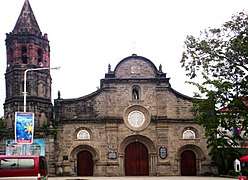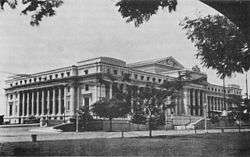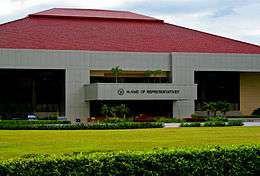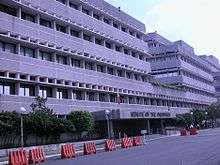Philippine Commission
 |
|---|
| This article is part of a series on the politics and government of the Philippines |
|
Constitutional commissions |
The Philippine Commission was the name of two bodies, both appointed by the President of the United States to assist with governing the Philippines.
The first Philippine Commission was appointed by President William McKinley on January 20, 1899 to make recommendations.
The second Philippine Commission, also known as the Taft Commission, was a body appointed by the President to exercise legislative and limited executive powers in the Philippines. It was first appointed by President McKinley in 1900 under his executive authority. The Philippine Organic Act was passed by the United States Congress in 1902; this enshrined into law the Commission's legislative and executive authority. As stipulated in the Philippine Organic Act, the bicameral Philippine Legislature was established in 1907, with the Commission as the upper house and the elected Philippine Assembly acting as lower house. The Jones Act of 1916 ended the Commission, replacing it with an elected Philippine Senate as the Legislature's upper house.
First Philippine Commission
On January 20, 1899, President McKinley appointed the First Philippine Commission (the Schurman Commission),[1] a five-person group headed by Dr. Jacob Schurman, president of Cornell University, to investigate conditions in the islands and make recommendations. In the report that they issued to the president the following year, the commissioners acknowledged Filipino aspirations for independence; they declared, however, that the Philippines was not ready for it. Specific recommendations included the establishment of civilian government as rapidly as possible (the American chief executive in the islands at that time was the military governor), including establishment of a bicameral legislature, autonomous governments on the provincial and municipal levels, and a system of free public elementary schools.[2]
Second Philippine Commission
| Philippine Commission (or the Second Philippine Commission) | |
|---|---|
| Type | |
| Type |
unicameral (1900–1907) upper house (1907–1916) of the Philippine Legislature |
| History | |
| Founded | March 16, 1900[3] |
| Disbanded | October 3, 1916 |
| Preceded by | none |
| Succeeded by | Philippine Senate |
| Leadership | |
From Philippines: A Country Study by Ronald E. Dolan:[4]
"The Second Philippine Commission (the Taft Commission), appointed by McKinley on March 16, 1900,[3] and headed by William Howard Taft, was granted legislative as well as limited executive powers. Between September 1900 and August 1902, it issued 499 laws. A judicial system was established, including a Supreme Court, and a legal code was drawn up to replace antiquated Spanish ordinances. A civil service was organized. The 1901 municipal code provided for popularly elected presidents, vice presidents, and councilors to serve on municipal boards. The municipal board members were responsible for collecting taxes, maintaining municipal properties, and undertaking necessary construction projects; they also elected provincial governors."[2] On 4 July 1901, Taft became governor of a civil administration for the Philippines.[5] This regime, called the Insular Government, administered the country until 1935.
"The Philippine Organic Act of July 1902 stipulated that a Philippine Legislature would be established composed of a lower house, the Philippine Assembly, which would be popularly elected, and an upper house consisting of the Philippine Commission. The two houses would share legislative powers, although the upper house alone would pass laws relating to the Moros and other non-Christian peoples. The act also provided for extending the United States Bill of Rights to Filipinos and sending two Filipino resident commissioners to Washington to attend sessions of the United States Congress. In July 1907, the first elections for the assembly were held, and the legislature opened its first session on October 16, 1907."[2][6]
Membership
Leaders
The body was led by the Governor-General of the Philippines:
- William Howard Taft (1901–1904)
- Luke Edward Wright (1904–1905)
- Henry Clay Ide (1905–1906)
- James Francis Smith (1906–1909)
- William Cameron Forbes (1909–1913)
- Francis Burton Harrison (1913–1916)
Other members
Secretary of Finance and Justice:
| Name | Month started | Month finished | |
|---|---|---|---|
| Secretaries of Finance and Justice | |||
| Henry Clay Ide | September 1, 1901 | September 24, 1906 | |
| James Francis Smith | September 25, 1906 | June 30, 1908 | |
| Gregorio S. Araneta | July 1, 1908 | October 30, 1913 | |
| Victorino Mapa | November 1, 1913 | January 14, 1917 | |
Secretary of the Interior:
| Name | Month started | Month finished | |
|---|---|---|---|
| Secretaries of the Interior | |||
| Dean C. Worcester | September 1, 1901 | 1913 | |
| Winfred Denson | 1913 | 1916 | |
Secretary of Commerce and Police:
| Name | Month started | Month finished | |
|---|---|---|---|
| Secretaries of Commerce and Police | |||
| Luke Edward Wright | September 1, 1901 | February 1, 1904 | |
| William Cameron Forbes | February 1, 1904 | 1909 | |
| Charles Elliott | 1910 | 1913 | |
| Clinton L. Riggs | 1913 | 1915 | |
| Eugene Reed | 1915 | 1916 | |
Secretary of Public Instruction:
| Name | Term started | Term finished | |
|---|---|---|---|
| Secretaries of Public Instruction | |||
| Bernard Moses | September 1, 1901 | 1902 | |
| James Francis Smith | 1902 | September 28, 1906 | |
| W. Morgan Shuster | September 28, 1906 | 1909 | |
| Newton W. Gilbert | 1909 | 1915 | |
| Henderson Martin | 1915 | 1916 | |
Philippine Members (1901–1909):
| Name | Term started | Term finished | |
|---|---|---|---|
| Philippine Members of the Philippine Commission | |||
| Benito Legarda | September 1, 1901 | December 21, 1907 | |
| Trinidad H. Pardo de Tavera | September 1, 1901 | March 1, 1909 | |
| Jose Ruiz de Luzuriaga | September 1, 1901 | 1913 | |
Philippine Members (1909–1913):
| Name | Term started | Term finished | |
|---|---|---|---|
| Philippine Members of the Philippine Commission | |||
| Rafael Palma | December 21, 1907 | 1913 | |
| Juan Sumulong | March 1, 1909 | 1913 | |
| Jose Ruiz de Luzuriaga | September 1, 1901 | 1913 | |
| Gregorio Araneta | 1909 | 1913 | |
See also
References and notes
- ↑ Halili 2004, p. 174
- 1 2 3 "Philippines: United States Rule". U.S. Library of Congress. Retrieved 2007-07-04.
- 1 2 Halili 2004, p. 179
- ↑ "Ronald E. Dolan, ed. Philippines: A Country Study. Washington: GPO for the Library of Congress, 1991". Retrieved 10 December 2010.
- ↑ Taft, William (1908). "Inaugural Address as civil Governor of the Philippines". Present Day Problems. Ayer Publishing. ISBN 978-0-8369-0922-7.
- ↑ "The Philippine Bill of July 1902". Filipiniana.net online digital library. July 1, 1902. Archived from the original on February 28, 2009. Retrieved 2008-01-07.
Bibliography
- Halili, Christine N. (2004). Philippine History. Rex Bookstore, Inc. ISBN 978-971-23-3934-9.
Further reading
External links
| Wikimedia Commons has media related to Philippine Commission. |
- "List of Senators". Senate of the Philippines. Archived from the original on 2007-02-07. Retrieved 2008-03-28.
- "The LAWPHiL Project - Philippine Laws and Jurisprudence Databank". Arellano Law Foundation. Archived from the original on 2001-11-29. Retrieved 2006-09-16. NB: very little material (if any) actually online
- "Acts of the Philippine Commission". LawPH.com. Retrieved 2010-09-13. NB: very little material (if any) actually online



